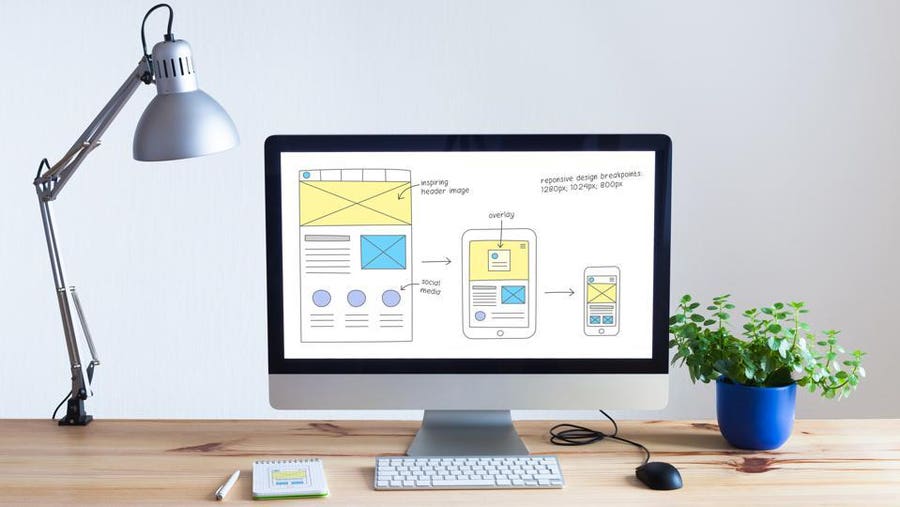Web App Development: Ultimate Guide for 2024

If you want to develop a web app, you need to use the right tools. They’re key to the success of your app, and they shouldn’t be overlooked. This article created by BizUpLab will present you with the available options, so let’s get started.
Front-End and Back-End Tools
Front-End Tools

Many front-end tools for web app development have been around for a long time, but the most reliable and popular ones include:
HTML
HTML (Hypertext Markup Language) is a fundamental tool for web app development. It provides the structure and semantic markup necessary for organizing and presenting content on the web, allowing developers to create the backbone of their applications.
JavaScript
JavaScript is a versatile programming language widely used in web app development. It adds interactivity and dynamic functionality to websites, allowing developers to create engaging user experiences through features like form validation, interactive elements, and real-time updates. With JavaScript, developers can enhance the functionality of their web apps and make them more responsive and interactive.
CSS
CSS (Cascading Style Sheets) is a crucial component in web app development. It enables developers to control the presentation and styling of web pages, allowing for consistent and visually appealing designs across different devices and browsers. With CSS, you can define colors, fonts, layouts, and other visual elements, ensuring a polished and professional look for your web app.
Back-End Tools

The most common options in terms of back-end tools are:
Databases
Databases, including analytics database, play a crucial role in web app development. They serve as a reliable and efficient means of storing, organizing, and managing data for your application. Whether it’s user profiles, product information, or transaction records, databases provide a structured environment for storing and retrieving information.
By selecting the appropriate database system, such as MySQL, PostgreSQL, or MongoDB, you can ensure the scalability, security, and performance of your web app’s data storage, enabling seamless user experiences and efficient data management.
Programming Languages

Programming languages are the backbone of web app development, providing the tools and syntax needed to build the logic and functionality of your application. There are various programming languages to choose from, each with its own strengths and areas of application. Popular choices for web development include languages like JavaScript, Python, Ruby, and PHP.
These languages offer robust frameworks, extensive libraries, and community support, empowering developers to create dynamic and feature-rich web apps. Selecting the right programming language(s) for your project is crucial as it influences the scalability, performance, and maintainability of your web app.
APIs
APIs (Application Programming Interfaces) play a pivotal role in web app development by facilitating communication and data exchange between different software components. APIs allow your web app to interact with external services, retrieve data from third-party sources, and integrate various functionalities seamlessly.
By leveraging APIs, developers can tap into a wealth of resources and services, such as social media platforms, payment gateways, mapping services, and more, to enhance the capabilities of their web apps. APIs provide a standardized and efficient way to connect and collaborate with external systems, enabling developers to create robust and interconnected web applications.
Servers
Servers are essential components in web app development, as they provide the infrastructure for hosting and delivering your application to users over the internet. A server acts as a central hub that stores your app’s files, processes requests from clients, and sends back the corresponding responses. It ensures the availability and accessibility of your web app by handling tasks such as data storage, security, and scalability.
Choosing the right server technology, whether it’s Apache, Nginx, or cloud-based solutions like AWS or Azure, is crucial for ensuring reliable performance and seamless user experiences for your web app.
Web Application Examples

Besides the tools above, there are also numerous web application examples that can inspire you and help you figure out how to make your own. BizUpLab Hungary presents you with some notable options:
Salesforce
Salesforce allows businesses to improve their customer service. It’s a CRM or customer relationship management service which takes advantage of the software-as-a-service model. What’s great about Salesforce is that it can also be integrated into different technologies, such as HubSpot CMS.
Mailchimp
If you ever want to send automated and targeted emails, Mailchimp is the way to go. It’s a marketing platform that makes targeted and automated mass emailing possible. What’s even better is that it’s straightforward and very easy to set up.
Google Docs
Google Docs allows you to write and edit documents as well as make suggestions on them, saving all your edits in an instant. It’s one of the most popular web applications because it makes document sharing a piece of cake.
How to Develop Your Own Web Applications
If you want to create your own web app, you should know that the process is similar to developing any other type of software. Let’s see what steps are required:
- Figure Out What You Want to Solve: The first step is defining your problem. What will your web application do, and what problems will it take care of? Think about your customers’ needs and what the application can help them with.
- Plan Your Workflow: Planning the perfect workflow will make sure the development of the app goes accordingly. Figure out every aspect that is necessary for developing your app and establish the features of the application. Then, you should figure out how you can meet the requirements using your budget and resources.
- Create a Prototype: Before launching the app, consider using a prototype. Prototypes are incomplete, yet functional applications that show you what your web app will look like in the end. This way, you can see where you should make improvements.If the prototype is good enough, it can give you validation, so you’ll be able to work on the project moving forward and launch a good product. You can also present the prototype to people who might be interested in it and ask for valuable feedback that you can implement into the project. BizUpLab Kft. is a reliable partner that can help you efficiently promote your project.
- Work on the App: It’s time to build your application. Take advantage of all the technologies and frameworks that fulfill your project requirements and make sure you use the right tools to develop the app.
- Perform Some Tests: Remember that you shouldn’t launch the app before performing some tests. These tests will help you see if the app is free of errors.
- Launch the Web App: Host the app on a web server and launch it. You can now provide individuals with solutions to their problems, but make sure you promote your app so that more people know about it.
Conclusion
There are many types of web apps out there, and developing one is a long and complex process. However, if you use the right technologies, you’ll certainly create a quality and useful app that will become successful over time. We’ll be happy to help you solve your business tasks. Contact BizUpLab Budapest today and receive a professional consultation.




